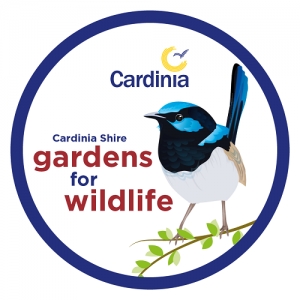Gardens for Wildlife program
Key points
- Gardens for Wildlife is a free program for Cardinia Shire residents which is growing and we would love you to be part of it!
- This program is all about helping residents create wildlife friendly gardens that support local biodiversity. And the best part? You get to help shape it!
- The program is a partnership between Cardinia Shire Council and Cardinia Environment Coalition

Why join the Gardens for Wildlife community?
By joining the program you will:
-
receive a welcome email with a voucher for six free indigenous plants to kickstart your garden. Vouchers are valid for six months, so you can plant when the time is right
-
receive a special plant voucher as a thank you for getting involved, when you attend a gardens for wildlife event like a workshop or planting day
-
receive regular updates with gardening tips, how to guides, and stories from other locals. You might even see your favourite plant featured!
-
help shape the program by sharing your interests and suggestions - this will help us plan workshops, planting days, talks etc
-
have networking opportunities that will help you meet other like minded gardeners, learn something new, and get your hands dirty.
How to get started?
No matter how big or small your property is you can create a garden that will attract wildlife. You can start out small by installing a cat safe bird bath to provide water to birds, have fun constructing an insect hotel, plant butterfly attracting plants, or you can go all out with a professionally landscaped garden.
Check out our factsheets that provide information on all the elements of a wildlife friendly garden including suggested indigenous plants to use. There are factsheets on how to design a garden in a contemporary, cottage, formal, or green lush style using indigenous plants.
Information on creating or improving your wildlife garden is available every Friday at the Cardinia Environment Coalition nursery during their opening times (9am-12pm)
Suggestions of items you can take to the nursery to help with your discussions:
- Photos of your property – this could just be of small sections you want to work on, or the whole backyard
- Hand drawn sketch with basic dimensions – include any existing elements, such as trees you want to keep, where the trampoline lives etc…
- Screen capture of google map with aerial photography of your property
- Property plan that includes the property boundaries – these are ideal if you have just built and moved into a new property, with no existing garden
Other resources
Down to earth e-newsletter
Sign up to our Down to earth bi-monthly e-newsletter for tips and tricks to improve your wildlife garden, including upcoming events, plus all the other great environmental news from Council (waste, climate change, heritage, water etc).
Indigenous plant guide
Indigenous plants are those that grow naturally in the area and so need less water, less fertiliser and less maintenance.
Our indigenous plant guide will help you to select plants that will grow best where you live because they suit local rainfall and soil types and provide habitat for native animals.
For every square metre of irrigated lawn you replace with a mulched bed of indigenous plants you save 400 litres of water per year!
Local indigenous nurseries list
Indigenous plants are not commonly available at your local nursery or hardware store.
View local indigenous plant nurseries here – these are staffed by volunteers who can help you choose the best plants for your garden.
Saving the Southern Brown Bandicoot
If you live in Bayles, Bunyip, Cora Lynn, Garfield, Heath Hill, Iona, Lang Lang, Maryknoll, Monomeith, Koo Wee Rup, Tynong or Yannathan, find out how you can help save our endangered Southern Brown Bandicoot
We acknowledge the assistance of Gardens for Wildlife Victoria and founding program Knox Gardens for Wildlife.
